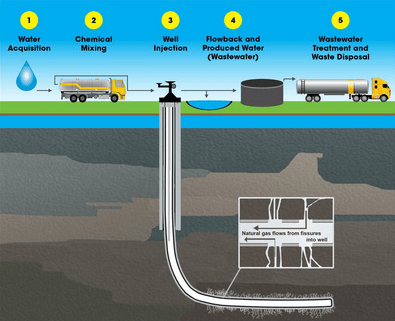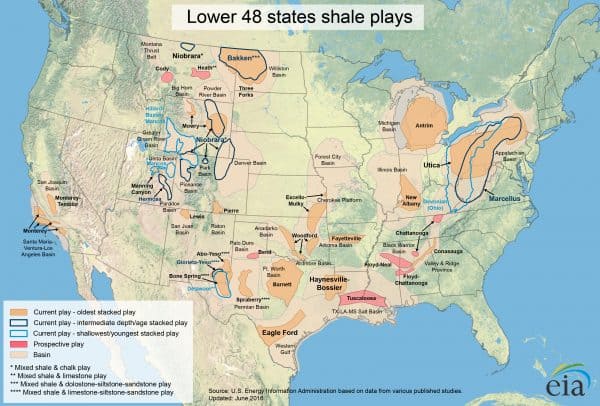This blog was originally posted by Croft employee Jessica Lee in 2015 and titled “The Marcellus Shale Gold Rush”, but I am changing the title to “The Shale Gold Rush”.
In the original blog, Jessica spoke about how the Marcellus shale was known to have natural gas. Still, the problem was how to get it, what shale gas is, and the environmental controversy surrounding the technique of fracking to recover gas from shale. While I plan to keep some of this information in this newly revised blog, I also plan to discuss the new controversy of overproduction in the U.S. shale plays and how this affects OPEC and oil prices.

I can see it, but I can’t reach it.

Have you ever dropped your phone or a French fry in between your car seats, and you can feel it, and you can see it, but you can’t quite get to it? That’s how drilling for natural gas in the shale plays used to feel. In the past, it was no secret that there were plentiful amounts of natural gas in the United State’s shale plays. The problem was how to get to it. There was much excitement when finding large pockets of natural gas. Still, unfortunately, there was no feasible economical way to recover these pockets, especially in the 1980s when gas prices were so low. When they reached these pockets, the gas flow would die down quickly, so drillers began to ignore them when they found them.
The reasoning of why they were unable to get to these large amounts of natural gas is because these regions are shale gas. In a brief definition, shale gas can be defined as a gas that is trapped in a low-permeability shale. The only way to recover this gas is to use the method of horizontal drilling and hydraulic fracturing (fracking) when drilling to allow the gas to flow to the well bore. This all began in 2008 and has since been viewed a modern-day gold rush due to the generous amounts of natural gas that have been recovered.
Economic Wonders
Economically, this has been huge for the United States. Once the fracking boom hit, natural gas production took off like a rocket fire.
When this blog was posted, the Marcellus shale was and is still the largest source of natural gas in the United States, bringing in over $11.2 billion in local revenue and creating over 139,000 jobs. The Marcellus shale region spans across 104,000 square miles through Pennsylvania, New York, West Virginia, and Ohio. All are all beautiful states, but I want to make sure to keep this blog focused on the United States shale production as a whole.
In 2014 as you all know, oil prices crashed when there became a surplus in the market which caused more than 240 production and exploration companies to close shop. In 2016 OPEC resumed the roll in restraining global oil output in hopes to help deplete the oil surplus and lift prices above $50 a barrel. Unfortunately, their efforts have not completely paid off yet. The shale producers in the United States have upped their game by finding ways to cut cost and extract more oil with smaller crews. Making this is the first time since the 1970s that the United States is finally able to hold their own in the competition for energy production against OPEC and Russia.

Now the Controversy
Many feel that all of the benefits that have come out of drilling for natural gas is not worth the environmental risks it has imposed. People are concerned about things such as spills, wastewater disposal, water contamination, emissions, and negative impacts that fracturing causes. In response, these states have imposed many regulations and taxes to help decrease the environmental impact as much as possible and help regulate the drilling and production of natural gas. Out of these and even out of the nation, Pennsylvania is among the strictest of these regulations. For example, in Pennsylvania it costs on average of $1 million more than it costs in other states mostly due to regulations and permitting.
In 2015, the Obama administration had tried to add federal regulations for fracking on federal lands, but even that was short lived and is being wiped out by the Trump administration. Once again fracking is not federally regulated but instead regulated by state governments due to federal agencies being forced to give up power to individual state governments. In America, Pennsylvania has some of the most comprehensive and multi-layered fracking regulations as compared to other states.
CROFT Production Systems designs, maintains and manufactures natural gas processing units that can help with some of these strict regulations. For Example, our Passive Dehydration System releases very little harmful emissions and requires no air permits which is a strict regulation in Pennsylvania. To learn more about Croft and our units, click on the links below.
Resources
https://www.eia.gov/petroleum/drilling/#tabs-summary-1
http://www.investors.com/research/industry-snapshot/oil-shale-threatens-opec-price-pact/
http://en.wikipedia.org/wiki/Marcellus_Formation#Natural_Gas
http://energyfactspa.com/natural-gas/page/pas-natural-gas-boom
http://en.wikipedia.org/wiki/Marcellus_natural_gas_trend
http://www.pittsburghquarterly.com/index.php/Marcellus-Shale/show-me-the-money.html












